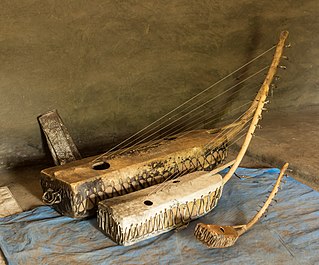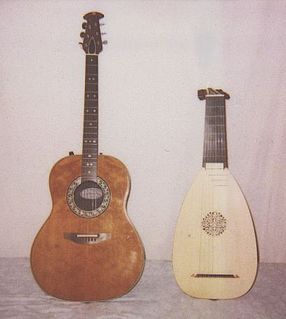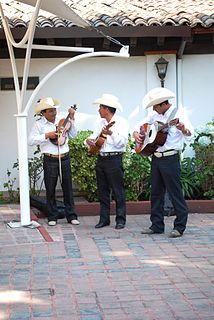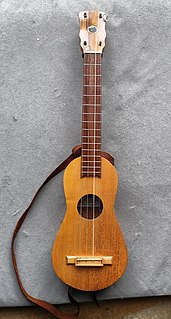Related Research Articles

The harp is a stringed musical instrument that has a number of individual strings running at an angle to its soundboard; the strings are plucked with the fingers. Harps can be made and played in various ways, standing or sitting and in orchestras or concerts. Its most common form is triangular in shape and made of wood. Some have multiple rows of strings and pedal attachments.

String instruments, stringed instruments, or chordophones are musical instruments that produce sound from vibrating strings when a performer plays or sounds the strings in some manner.
The music of Latin America refers to music originating from Latin America, namely the Romance-speaking regions of the Americas. Latin American music also incorporates African music from enslaved African people who were transported from West and Central Africa to the Americas by European settlers, as well as music from the Indigenous peoples of the Americas. Due to its highly syncretic nature, Latin American music encompasses a wide variety of styles, including influential genres such as cumbia, bachata, bossa nova, merengue, rumba, salsa, samba, son, and tango. During the 20th century, many styles were influenced by the music of the United States giving rise to genres such as Latin pop, rock, jazz, hip hop, and reggaeton.
The term conjunto refers to several types of small musical ensembles present in different Latin American musical traditions, mainly in Mexico and Cuba. While Mexican conjuntos play styles such as norteño and tejano, Cuban conjuntos specialize in the son, as well as its derivations such as salsa.

The music of Mexico is very diverse and features a wide range of musical genres and performance styles. It has been influenced by a variety of cultures, most notably the culture of the Europeans and Natives. Music was an expression of Mexican nationalism, beginning in the nineteenth century.

The joropo is a musical style resembling the fandango, and an accompanying dance. It originated in Venezuelan territory and is also present in the eastern Colombian plains. It has African, Native South American, and European influences. There are different joropo variants: tuyero, oriental, and llanero. It is a fundamental genre of Venezuelan música criolla. It is also the most popular "folk rhythm": the well-known song "Alma Llanera" is a joropo, considered the unofficial national anthem of Venezuela.
The term requinto is used in both Spanish and Portuguese to mean a smaller, higher-pitched version of another instrument. Thus, there are requinto guitars, drums, and several wind instruments.

Bajo sexto is a Mexican string instrument from the guitar family with 12 strings in six double courses. A closely related instrument is the bajo quinto which has 10 strings in five double courses.

The jarana jarocha is a guitar-shaped fretted stringed instrument from the southern region of the state of Veracruz, Mexico. Typically strung with 8 strings in 5 courses, usually arranged in two single outer strings with three double-courses in between. The strings are usually nylon, although they were gut in the past. The body is somewhat narrower than a guitar because of its direct lineage from the Spanish baroque guitar of the sixteenth century. Sometimes mistaken for a ukulele, the jarana jarocha comes in at least five sizes, the smallest being the chaquiste, somewhat smaller than a soprano ukulele; then the mosquito, about the size of a soprano ukulele; the 'primera', about the size of a concert ukulele; the 'segunda', in length between a tenor and a baritone ukulele; and the 'tercera', somewhat longer than the baritone ukulele. Some luthiers are building jaranas of a size they label "tercerola" or "jarana cuarta", but there is some discussion as to whether these represent a distinct size or are merely particularly large variations of the standard tercera.
Regional styles of Mexican music vary greatly vary from state to state. Norteño, banda, duranguense, Son mexicano and other Mexican country music genres are often known as regional Mexican music because each state produces different musical sounds and lyrics.

The a'dungu, also called the ekidongo or ennenga, is a stringed musical instrument of the Alur people of northwestern Uganda. It is an arched harp of varying dimensions, ranging from seven to ten strings or more.

Plucked string instruments are a subcategory of string instruments that are played by plucking the strings. Plucking is a way of pulling and releasing the string in such a way as to give it an impulse that causes the string to vibrate. Plucking can be done with either a finger or a plectrum.

Son jarocho is a regional folk musical style of Mexican Son from Veracruz, a Mexican state along the Gulf of Mexico. It evolved over the last two and a half centuries along the coastal portions of southern Tamaulipas state and Veracruz state, hence the term jarocho, a colloquial term for people or things from the port city of Veracruz.

Son huasteco is one of eight Mexican song styles and is a traditional Mexican musical style originating in the six state area of Northeastern Mexico called La Huasteca. It dates back to the end of the 19th century and is influenced by Spanish and indigenous cultures. Usually it is played by a Trio Huasteco composed of a guitarra quinta huapanguera a Jarana huasteca and a violin. Singers will often use the falsetto register. The son huasteco is particularly noteworthy for its flamboyant and virtuoso violin parts, although the style varies from state to state. Footwork often danced to son huasteco is the Zapateado. Improvisation plays a strong role in the style, with musicians creating their own lyrics and arrangements to a standard repertoire. Typical sones huastecos are "Cielito lindo", "La huazanga", "La sirena", "El querreque" and "La cigarra".

The requinto jarocho or guitarra de son is plucked string instrument, played usually with a special pick. It is a four- or five-stringed instrument that has originated from Veracruz, Mexico.
Son jalisciense is a variety of Mexican son music from which modern mariachi music is derived. This son also relied on the same basic instruments, rhythms and melodies as the sones of Veracruz and other locations, using the same string instruments. By the 19th century, Son jalisciense developed to be played with one vihuela, two violins and a guitarrón. The best known song of this type of son is called “La Negra”. Modern mariachi developed when brass instruments such as trumpets were added.

The leona is a guitar-shaped fretted stringed instrument, from the state of Veracruz, Mexico. It has four strings and is a low pitched instrument in the son jarocho string family of instruments. The león or vozarrona, bigger than the former, is the lowest instrument in son jarocho genre.
The Guitarra de golpe is a stringed musical instrument from Mexico. It has 5 nylon strings in 5 courses. The headstock traditionally has a traditional shape that is designed to look like a stylised owl with wooden pegs, but nowadays this is sometimes replaced with a guitar or vihuela style headstock with machine heads. For a while during the 20th century, the Guitarra De Golpe fell into disuse in traditional Mariachi groups, and was replaced by the Classical guitar. It has now however been revived. It is still an essential part of the "conjuntos de arpa" from Michoacán.

Folk dance of Mexico, commonly known as baile folklorico or Mexican ballet folk dance, is a term used to collectively describe traditional Mexican folk dances. Ballet folklórico is not just one type of dance, it encompasses each region's traditional dance that has been influenced by their local folklore and has been entwined with ballet characteristics to be made into a theatrical production. Each dance represents a different region in Mexico illustrated through their different zapateado, footwork, having differing stomps or heel toe points, and choreography that imitates animals from their region such as horses, iguanas, and vultures.

Son mexicano is a style of Mexican folk music and dance that encompasses various regional genres, all of which are called son. The term son literally means "sound" in Spanish, and is also applied to other unrelated genres, most notably son cubano.
References
- 1 2 3 4 Courteau, Mona-Lyn and Daniel Sheehy (2003). "Part III Musical Instruments: 13. Stringed Instruments: Harp.". In John Shepherd; et al. (eds.). Continuum Encyclopedia Of Popular Music Of The World. Vol. 2. Bloomsbury Academic. pp. 427–437. ISBN 9780826463227.
- 1 2 Ortiz, Alfredo Orlando (1991). "History of Latin American Harps". Harp Spectrum. Retrieved 30 September 2013.
- ↑ Atlas Cultural de México. Música. México: Grupo Editorial Planeta. 1988. ISBN 968-406-121-8.
- 1 2 "Harp Spectrum".